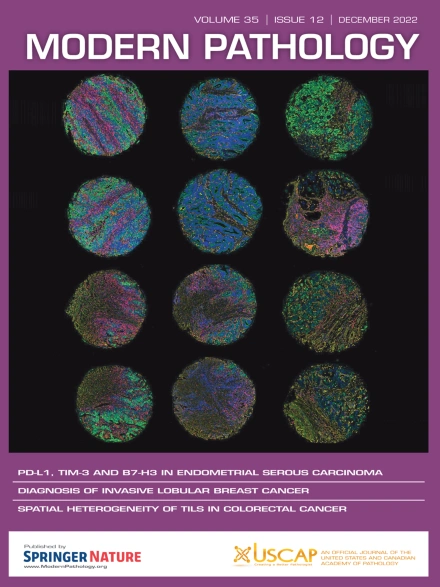Shared Features of Obliterative Portal Venopathy, Normal Liver, and Chronic Liver Disease: A Histologic and Morphometric Analysis
IF 7.1
1区 医学
Q1 PATHOLOGY
引用次数: 0
Abstract
Obliterative portal venopathy (OPV) is a cause of noncirrhotic portal hypertension, and its diagnosis is challenging, as the features are heterogeneous, subtle, and may be mistaken as “normal.” We sought to compare OPV cases (n = 72; 326 total portal tracts [PT]) with 2 control groups: control group 1 comprised of normal liver (n = 40; 192 PTs) and control group 2 comprised of liver biopsies with chronic liver disease with OPV features (n = 40; 200 PTs). Morphometry was applied to determine the overall PT area and the luminal area of dystrophic portal veins (PVs). The frequency of absent native PVs was determined. Using trichrome-stained slides, approximately 5 PTs were randomly selected for morphometry utilizing Philips IntelliSite Pathology Solution 3.3. Clinical data were extracted from electronic health records. Of the 326 PTs in the OPV cases, phlebosclerosis was found in 31.6%, densely fibrotic PTs in 12.7%, dystrophic PVs in 31.4%, and absent native PVs in 44.5%. When comparing the OPV group with control group 1, dystrophic PVs, absent native PVs, phlebosclerosis, fibrotic PTs, greater luminal area of dystrophic PV, and a higher ratio of dystrophic PV area to PT area were more frequently found in the OPV group. No significant difference in overall PT area was found. When comparing control group 2 with OPV cases, densely fibrotic PTs were more frequent when compared with OPV cases. This study shows that absent native PVs are the most frequent feature in OPV. Other features that are less frequent but still significantly different from normal liver include dystrophic PVs, greater luminal area of dystrophic PVs, phlebosclerosis, and PT fibrosis. Except for densely fibrotic PTs in control group 2, all other features showed similar frequency as OPV. Pathologists should be aware that OPV features may be present in liver biopsies from both normal and chronic liver diseases.
闭塞性门脉病、正常肝脏和慢性肝病的共同特征:组织学和形态学分析。
闭塞性门静脉病变(OPV)是一种非肝硬化门静脉高压的病因,其诊断具有挑战性,因为其特征是异质性的,微妙的,并且可能被误认为“正常”。我们试图比较脊髓灰质炎病例(n=72;326个总门静脉束[PT],两组对照:对照组1正常肝(n=40;192名患者)和对照组2,包括肝活检并伴有OPV特征的慢性肝病(n = 40;200分)。形态学测定法测定了营养不良门静脉(pv)的总PT面积和管腔面积。测定原生pv缺失的频率。使用三色染色的载玻片,使用Philips IntelliSite Pathology Solution 3.3随机选择约5个PTs进行形态测定。临床数据从电子健康记录中提取。在326例OPV患者中,静脉硬化占31.6%,致密纤维化占12.7%,营养不良性pv占31.4%,原生pv缺失占44.5%。OPV组与对照1组比较,OPV组出现营养不良PV、原生PV缺失、静脉硬化、纤维化PV、营养不良PV管腔面积增大、营养不良PV面积与PT面积之比增大。两组PT总面积无明显差异。对照2组与OPV病例比较,致密纤维化PTs发生率高于OPV病例。本研究表明原生pv缺失是OPV最常见的特征。其他不常见但仍与正常肝脏有显著差异的特征包括营养不良的pv,营养不良pv的管腔面积更大,静脉硬化和PT纤维化。除对照组2中出现致密纤维化PTs外,其他特征均与OPV出现频率相似。病理学家应该意识到,正常和慢性肝病的肝活检都可能出现OPV特征。
本文章由计算机程序翻译,如有差异,请以英文原文为准。
求助全文
约1分钟内获得全文
求助全文
来源期刊

Modern Pathology
医学-病理学
CiteScore
14.30
自引率
2.70%
发文量
174
审稿时长
18 days
期刊介绍:
Modern Pathology, an international journal under the ownership of The United States & Canadian Academy of Pathology (USCAP), serves as an authoritative platform for publishing top-tier clinical and translational research studies in pathology.
Original manuscripts are the primary focus of Modern Pathology, complemented by impactful editorials, reviews, and practice guidelines covering all facets of precision diagnostics in human pathology. The journal's scope includes advancements in molecular diagnostics and genomic classifications of diseases, breakthroughs in immune-oncology, computational science, applied bioinformatics, and digital pathology.
 求助内容:
求助内容: 应助结果提醒方式:
应助结果提醒方式:


